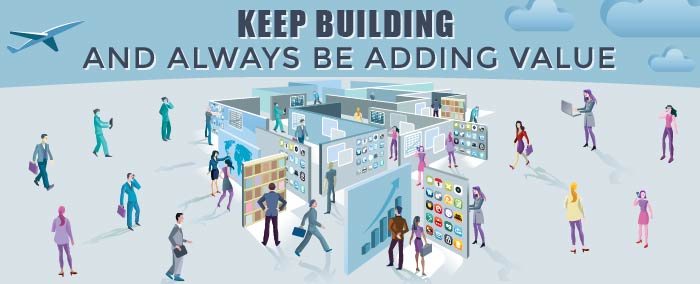So 15, heck, maybe even 10 years ago, you were probably one of the many skeptics who didn’t quite see the value in having a website.
Pay lots of money to someone that hibernates all year in a dark basement behind their computer, developing a site for you in some hieroglyphic coding, so you (and your site visitors) can be frustrated when the needle didn’t move? No thanks.
Things sure do change fast.
Today your business probably doesn’t exist, or at least turn a profit, if you are not online in some form.
Okay, let’s assume you bit the bullet and have a website. Now that you’re online profits are soaring….right?
Wrong.
Just because you are online today – have a website, Facebook page, and maybe threw some spaghetti at Google AdWords and SEO to see what stuck, does NOT mean you are marketing your business effectively.
But we’re not telling you anything new, that’s how life is for most small businesses online. Actually, many of them don’t even know how to gauge the “effectiveness” of their online presence. And this is a very fundamental problem, that when corrected, changes everything.
But first let me throw one more metaphor at you:
You want to get healthy and fit so you pay for a bunch of books on exercise and buy a gym membership but you never read the books and never go to the gym.
Sounds pretty stupid, right?
Well, that’s exactly what some small business owners are doing by creating themselves a nifty little website and praying that people land on it. If only the internet gods had a 1-800 number we could all dial and just put our requests in: “Hi internet gods! I have a request for next month. I need about 400 middle aged women to find my website and buy my new yoga line that makes them feel young and beautiful. Thanks!”
Okay, I went a little far with that one but I kid you not – this type of insanity is running budding businesses, full of potential, straight into the ground.
So, what’s my point?
There are a lot of factors that go into achieving a successful marketing campaign. And they don’t need to remain a mystery. In fact, let’s get the first one super clear:
Market Research. Say that three times. Market research, market research, market research. You have no business selling anything online before you do your market research.
At D4Y, we NEVER touch a project before  completing our market research. Meaning, we head out onto the world wide web and see what’s happening in our clients’ space, see what’s being sold effectively, when it’s selling, who it’s selling to, and how they’re selling it. This is all so we can better develop a campaign that will produce results!
completing our market research. Meaning, we head out onto the world wide web and see what’s happening in our clients’ space, see what’s being sold effectively, when it’s selling, who it’s selling to, and how they’re selling it. This is all so we can better develop a campaign that will produce results!
However, during this market research, we come across a lot of websites and brands that, for lack of better words, could use some help…
Simply put, many businesses are not making the best use of their website and marketing efforts.
So what are they doing wrong, you may ask?
We consistently see businesses making the same three, killer mistakes. Mistakes that in 2016, you simply cannot afford to make… because by 2017 you will be out of business.
If you want to not only keep up with the times but also keep more money in your pocket, heck, even create more money to put in your pocket, keep reading…
Mistake #1: Not establishing who you are
One of the most common and detrimental mistakes we see from businesses today is a lack of establishing and communicating who they are. This would seem kind of obvious, right?
Well, you would be surprised how many companies don’t mention who they are, why they exist and what their mission is on their website.
In essence, they’ve lost before they even started.
These also tend to be the same companies that claim they are doing online marketing but nothing is working…go figure!
Why is stating who you are and what your mission is, so important?
That is the easiest way for your audience (another bone to pick that we’ll get to later) to resonate with you and quickly determine if their values align with your brand’s values.
When someone learns who you are, it immediately creates trust and rapport. Now that website visitor, is closer to becoming a customer or client.
If you lack this content on your website, it becomes harder for visitors to resonate with you and your message, deterring them from ever doing business with you.
In a digital world where there is competition everywhere you look, it is vital that you stand out. Being clear about who you are is what makes you stand out! No one can be you.
If you are hoping that random traffic from the internet happens to stumble upon your website, enjoy the little logo design in the top left corner, navigate their way through the clutter of information that tells them nothing about who you really are, and instantly pull out their wallets to buy something from you, you’re dreaming.
The entrepreneur’s guide, Start With Why, written by the highly sought after thought leader, Simon Sinek, illustrates the importance for not only businesses, but everyone, to start with WHY.
Why do you wake up every morning?
Why are you in business?
Why do you do what you do?
In his book, Sinek states: “People don’t buy what you do, they buy why you do it.” Think about it; the best selling brands in the world don’t merely exist to make money. Of course, they are in business for a profit, but their legacy is what drives them to be great.
Steve Jobs, Apple’s late CEO, lead the company with this vision for their why: “To make a contribution to the world by making tools for the mind that advance humankind.” Today, Apple sells the #2 smartphone on the market, is one of biggest producers of computers, remains the biggest online music hub and has recently broken into the TV scene. As you can see, Jobs’ mission and vision, and his why for Apple, has lead them to change the game in multiple industries.
 Every product they produce is in alignment with this why; from design, to use to marketing.
Every product they produce is in alignment with this why; from design, to use to marketing.
Apple has a purpose and a mission that people want to be a part.
Isn’t it easy to see when a company leads with a driving mission, purpose and vision, they can come to not only dominate but influence change amongst multiple industries, and attract millions of loyal households worldwide?
Mistake #2: Jack-of-All Trades, Master of None
This one can be bad, really bad.
Way too many businesses want to be everything to everyone, rather than mastering their own craft and appealing to a specified audience.
When you know that you are damn good at one thing, you don’t need to reinvent the wheel to try to win over everyone.
There are so many companies in the marketplace today that focus a mile wide and an inch deep, instead of an inch wide and a mile deep.
What I mean by this, is that real success comes from depth. You cannot win a championship without a bench. One hit wonders in the entertainment biz never get remembered. Top chefs never own a fleet of mediocre restaurants. The same goes for entrepreneurs.
You get the point. Find YOUR niche and dig deep in the trenches to strike gold! Create value, build your portfolio, establish customers for life and not customers for a paycheck.
Once you’ve established yourself as an expert or authority in a specific niche, it is critical that you define your audience.
If you are in the food industry, you can’t say that your target market is “everyone” simply because everyone has to eat. Is your focus on organic? Italian? Fast food? Etc.
If you’re creating an online marketing course, who are you speaking to? The beginners? Advanced marketers? Do you focus on Facebook marketing? Brand messaging?
The more defined and specific your avatar, the higher quality client you will attract.
Why is this?
If you know exactly the type of person you want to sell your products or services to, it makes it a heck of alot easier to not only find them, but for them to find you. If you’re offering them exactly what they want then you’re already speaking to them in ways that they will respond.
I come across a lot of business and life coaches on the internet regularly. It appears everyone out there today is a business and life guru, but I digress…
Most of these coaches seem to have no idea who their ideal client is, so instead of speaking to a specific niche, they speak to the masses, and attract no one. Are you a high-level business coach or a struggling single-parent life-coach? Are you a weight-loss coach or a bodybuilding competition coach? Do you coach people on building businesses or closing sales?
There are major differences amongst all of these!
People are extremely picky about where they spend their disposable income, so if you speak to everyone in your messaging, chances are you are going to speak too broadly for your ideal customer to hear you and miss the opportunity to work for them.
Ever heard of Bulletproof?
Most well known for their addition of butter to coffee and popularizing the term “biohacking”?
 Founder Dave Asprey understood that there were successful systems in place for sports franchises to win championships, real estate professionals to sell eight-figures worth of homes in a year, why not develop a health formula for people to work, think and live more productively?
Founder Dave Asprey understood that there were successful systems in place for sports franchises to win championships, real estate professionals to sell eight-figures worth of homes in a year, why not develop a health formula for people to work, think and live more productively?
Bulletproof sticks to biohacking and biohacking only.
They don’t wander off into manufacturing technology products or even bringing soda into your home. They know what they are best at and they stick to that. Making their name, and the Bulletproof lifestyle trend, spread virally.
So, want a quick fix to mastering your trade while avoiding becoming the jack of all of them?
Find your favorite hat, wear it damn well and become the hero business for your defined audience.
Mistake #3: Not Tracking Customers
This one’s pretty straight forward. In laymen terms, if you are not tracking your customer statistics in 2016, you simply cannot expect to ever “crush it” in your business online.
For those who are keeping up with the times, technology enables you to track every action taken by your clients. From the second someone lands on your site to the time they, well, leave, you must be tracking what your client is doing.
What kind of power would you have with your business if you knew:
- How long your average visitor was staying on your website?
- Where they clicked on the most on your site?
- The email address of every potential lead?
- The percentage of people purchasing something when they visited your site?
- How long leads were staying on your site without buying what they put in their cart?
- Whether a lead ever returned to your site ever again?
 Knowing all of this and more, can mean the difference between a successful business and a shop that has to close it’s virtual doors… for good.
Knowing all of this and more, can mean the difference between a successful business and a shop that has to close it’s virtual doors… for good.
So, why aren’t you doing it?!
I cannot tell you the number of websites that I visit who don’t really care what I want or ever really care to get to know me, let alone even ask me for my email address to stay in touch. It’s like ending a date without ever asking when you can see the person again. Basically, I’ve lost interest before I even click off that site.
Like I mentioned earlier, there is a science to it all. If you’re not implementing the systems that work, it’s most likely because you didn’t even know there were systems… nevermind how to implement them.
I want to convey to you the importance of doing all of this.
First off, obtaining their email address is the minimum you should be doing when someone lands on your page – for a multitude of reasons.
The main reason you’ll want to catch their email is so you can deliver a free gift to them. People like, I mean love, free stuff.
If you are a weight-loss coach, and someone lands on your site and sees a free eBook showing them “5 things you can do today to lose weight”, you’re in! They will undoubtedly give you their email in exchange for that freebie.
Once you have their email, you can communicate with them a bit differently. You can send them a series talking a little bit about who you are and what you have accomplished (to build trust and rapport) but more importantly, share why you do what you do. Get them relating to you.
Second, tracking conversions and cart abandonment means knowing the numbers in your business in a whole new level.
Having the ability to contact someone after they abandon their cart can drive sales through the roof!
I was speaking to a business owner the other day and they said by merely beginning to track this number, they were able to increase sales by 34% in 1 month!
They had a lot of traffic to their site, a lot of people adding things to the shopping cart, but a large percentage of people not finalizing the purchase.
With a simple email and $10 off coupon for first-time customers if they completed the purchase within 24 hours, sales came pouring in over the next month.
These are just two examples of tracking your customers and what they can do to your business. Imagine if you only implemented these two things?
What if you implemented five more?
What would that do to your bottom line?
Let’s take a quick look at Amazing. I mean Amazon.
Amazon as we all (or at least should) know, is the largest online retailer on the planet and is expected to reach $100+ billion, with a “B”, in revenue for 2016. I think the proof is in the pudding but those numbers show that they’re definitely doing something right.
One of the greatest and revenue-generating tools on Amazon’s site is the “people who’ve purchased this item also liked…”.
Boom!
They learn your buying habits, present to you what they know you will like, you click a button and next thing you know it’s at your doorstep in two days thanks to Prime.
Can you imagine what this has done to their revenue?
They also track you, your buying habits and your searches quite closely, which you would realize if you ever saw an Amazon ad following you around the web with an item you recently looked at.
These are the little nuances of tracking which, over time can create a massive shift in your bottom line numbers.
The saying goes, “What is not tracked, is not done.” In this case meaning, if you’re not tracking your customers, you can’t capitalize or monetize all of the information at your disposal
It’s amazing what can happen to your business when you begin to make tiny shifts little by little. Whether it’s gathering your team and establishing your core mission, defining who your audience is or maybe even adding a tracking tool or two to your site, you can probably see the compound effect of doing so.
Finally, with technological resources at your disposal like never before, it’s crucial that you employ these techniques ASAP, unless of course you struggle mightily from mistake #1, in which case you should get a move on it yesterday!
If your business struggles from any of these common mistakes, maybe you can use some help. We’d be happy to offer you a FREE 15-minute strategy session and assist you with implementing these tactics properly into your business. At D4Y, our mission is to help you help yourself impact more people with your products and services!
Sign up for your FREE strategy session HERE.
Read More...







 completing our market research. Meaning, we head out onto the world wide web and see what’s happening in our clients’ space, see what’s being sold effectively, when it’s selling, who it’s selling to, and how they’re selling it. This is all so we can better develop a campaign that will produce results!
completing our market research. Meaning, we head out onto the world wide web and see what’s happening in our clients’ space, see what’s being sold effectively, when it’s selling, who it’s selling to, and how they’re selling it. This is all so we can better develop a campaign that will produce results!
 Every product they produce is in alignment with this why; from design, to use to marketing.
Every product they produce is in alignment with this why; from design, to use to marketing.
 Founder Dave Asprey understood that there were successful systems in place for sports franchises to win championships, real estate professionals to sell eight-figures worth of homes in a year, why not develop a health formula for people to work, think and live more productively?
Founder Dave Asprey understood that there were successful systems in place for sports franchises to win championships, real estate professionals to sell eight-figures worth of homes in a year, why not develop a health formula for people to work, think and live more productively? Knowing all of this and more, can mean the difference between a successful business and a shop that has to close it’s virtual doors… for good.
Knowing all of this and more, can mean the difference between a successful business and a shop that has to close it’s virtual doors… for good.


 For a life or health coach this service may be one-on-one coaching; for a real estate broker this might be buying/selling a home, and for an online personal trainer, this could be a 12-week digital training program with workout and nutritional guides.
For a life or health coach this service may be one-on-one coaching; for a real estate broker this might be buying/selling a home, and for an online personal trainer, this could be a 12-week digital training program with workout and nutritional guides. A profit maximizer usually is designed as a mastermind, intimate group workshop, more personalized time or even a bundled offer of your core products. As you can see, it often involves more of YOUR personal time (or more of your products), meaning people are willing to pay a premium for it!
A profit maximizer usually is designed as a mastermind, intimate group workshop, more personalized time or even a bundled offer of your core products. As you can see, it often involves more of YOUR personal time (or more of your products), meaning people are willing to pay a premium for it!  even the importance of the value ladder.
even the importance of the value ladder. 
 Do you wish you could use the information you knew about your customers to target the right people with the right message, at the right time… in the right place… with total ease?
Do you wish you could use the information you knew about your customers to target the right people with the right message, at the right time… in the right place… with total ease? Now, we all know what a standard boring website looks like: too much blank space in the wrong places, some ugly distracting color scheme, way too much text (that we never read), maybe some tabs on top sending us everywhere and nowhere all at once and occasionally… hidden somewhere on the home page… a magical box for us to type our precious email address into so they can send us their wildly uneventful monthly newsletters that we won’t ever read. That may have been a run-on sentence but I made my point, right?
Now, we all know what a standard boring website looks like: too much blank space in the wrong places, some ugly distracting color scheme, way too much text (that we never read), maybe some tabs on top sending us everywhere and nowhere all at once and occasionally… hidden somewhere on the home page… a magical box for us to type our precious email address into so they can send us their wildly uneventful monthly newsletters that we won’t ever read. That may have been a run-on sentence but I made my point, right?
 Depending on your niche, the profit maximizer can be a mastermind program, higher level coaching offer, paid live workshop or even a bundled package of your products/services. This is called the profit maximizer because your profit margin on these deliverables is often very large! You already have the customer and over their course of going through your funnel, have more than covered your cost to acquire them.
Depending on your niche, the profit maximizer can be a mastermind program, higher level coaching offer, paid live workshop or even a bundled package of your products/services. This is called the profit maximizer because your profit margin on these deliverables is often very large! You already have the customer and over their course of going through your funnel, have more than covered your cost to acquire them.



